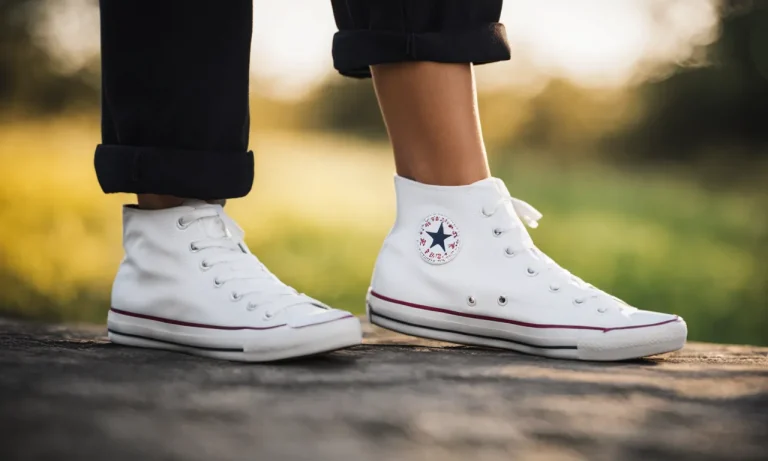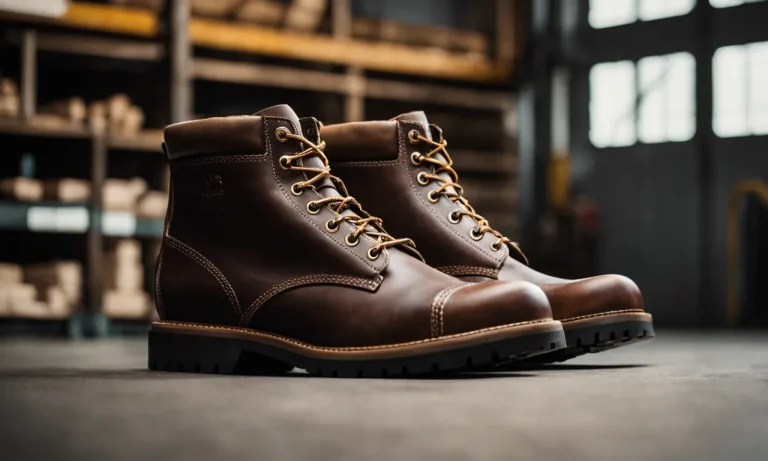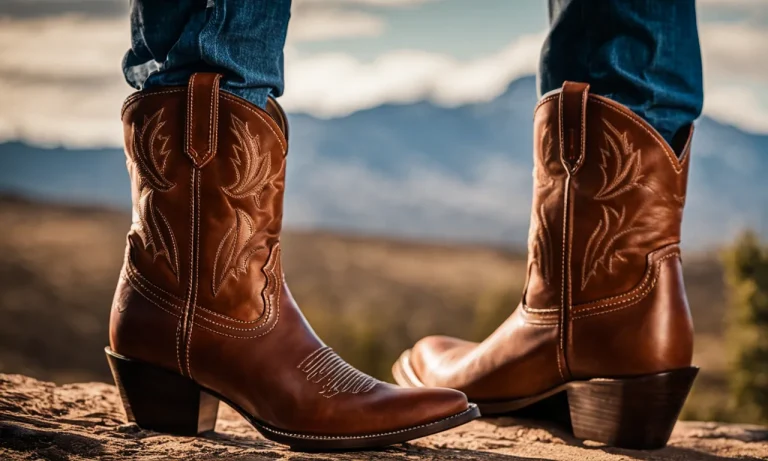Getting your boots stuck in thick, sticky mud can be incredibly frustrating. No matter how hard you pull, your boots seem cemented in place by the mud. If you’re short on time, here’s a quick answer to your question: Use a stick, branch or other solid object to break up and dislodge the mud around your boots.
Rock your leg back and forth while pulling up at the same time. Have a friend pull from above while you pull from below.
In this comprehensive guide, we’ll provide an in-depth look at the best techniques for freeing your boots when they get stuck in mud. We’ll cover preparation tips, the physics of how mud traps boots, step-by-step instructions for different methods, and safety precautions to take.
Be Proactive: Avoid Getting Stuck in the First Place
Getting stuck in mud can be a frustrating and time-consuming experience. However, with a little bit of planning and preparation, you can avoid this situation altogether. Here are some proactive steps you can take to ensure that you don’t get stuck in the first place.
Wear Appropriate Footwear for Muddy Conditions
One of the most important factors in avoiding getting stuck in mud is wearing the right footwear. Choose boots that are specifically designed for muddy conditions, with deep treads that provide excellent traction. These boots will help you navigate through muddy terrain without sinking in.
Additionally, consider investing in gaiters, which are protective covers worn over your boots and lower legs. Gaiters can help keep mud out of your boots, preventing them from becoming weighed down and increasing the likelihood of getting stuck.
Take Off Excess Weight
Another way to prevent getting stuck in mud is to reduce the weight you carry. Before embarking on your muddy adventure, take a moment to evaluate what you really need to bring along. Remove any unnecessary items from your backpack or gear, as carrying excess weight can make it more difficult to navigate through muddy terrain.
Remember, every pound you shed is one less pound that could potentially contribute to you getting stuck. So, lighten your load and increase your chances of staying on solid ground.
Use Trekking Poles for Balance
Trekking poles can be a great tool for maintaining balance and stability in muddy conditions. By using trekking poles, you can distribute your weight more evenly and reduce the risk of slipping or sinking into the mud.
When using trekking poles, make sure to plant them firmly in the ground before taking a step. This will provide you with added stability and help prevent your boots from getting stuck in the mud. Remember, prevention is key!
By following these proactive steps, you can significantly reduce the chances of getting stuck in mud. Remember to always be prepared and make smart decisions when venturing into muddy terrain. Stay safe and enjoy your outdoor adventures!
Understand How Mud Traps Boots
Walking through mud can be a challenging and messy experience, especially when your boots get stuck. Understanding how mud traps boots can help you navigate through muddy terrain more effectively. There are two main factors that contribute to this problem: the suction cup effect and the glopping factor.
Suction Cup Effect
The suction cup effect is a phenomenon that occurs when your boot creates a vacuum seal with the mud. As you step down, the mud fills the space between the sole of your boot and the ground. When you try to lift your foot, the air pressure inside the sealed space increases, creating a suction force that makes it difficult to pull your boot out of the mud.
It’s like trying to lift a suction cup off a smooth surface – the more you pull, the stronger the grip.
This suction cup effect is particularly pronounced in wet and sticky mud, where the mud particles adhere to the sole of your boot and create a stronger seal. It can make walking through muddy areas feel like you’re wearing weights on your feet.
Glopping Factor
The glopping factor refers to the accumulation of mud between the treads and grooves of your boot’s sole. When you step into mud, the sticky nature of it causes mud to get trapped in the crevices of your boots.
As you continue to walk, the mud builds up, making your boots heavier and reducing traction. This can significantly impede your ability to move freely and increase the chances of your boots getting stuck.
To minimize the glopping factor, it is essential to choose boots with well-designed treads that allow mud to be easily released. Boots with self-cleaning treads or those made of materials that repel mud can be particularly helpful in preventing excessive mud accumulation.
Understanding these two factors can help you better prepare for walking in muddy conditions. By being aware of the suction cup effect and the glopping factor, you can take proactive measures to prevent your boots from getting stuck and ensure a more enjoyable outdoor experience.
Techniques to Break the Suction
Use a Solid Object to Break Up the Mud
When your boots are stuck in mud and it feels like they’re glued to the ground, one effective technique to break the suction is to use a solid object. Look around for a sturdy stick, a metal rod, or even a large rock.
Carefully insert the object into the mud near your boot and use it to break up the suction. Wiggle it back and forth and side to side to loosen the grip of the mud. Be cautious not to damage your boot or injure yourself in the process.
Rock Your Leg While Pulling
If you find yourself struggling to free your stuck boots from the mud, try rocking your leg while pulling. While holding onto a stable object for support, gently rock your leg back and forth. This motion can help to create small shifts in the mud, gradually breaking the suction.
As you rock your leg, continue to exert a steady pulling force to further aid in the release of your boots.
Have a Partner Pull From Above
Getting assistance from a partner can be a game-changer when it comes to freeing your boots from mud. If you have a willing helper, ask them to stand on solid ground and pull on your leg from above. This pulling force from a different angle can help to counteract the suction and make it easier to break free.
Communication between you and your partner is crucial to ensure a synchronized effort and avoid any potential injuries.
Remove Your Foot From the Boot
If all else fails and your boots are still firmly stuck in the mud, you may need to remove your foot from the boot itself. This can be a last resort, but sometimes it is necessary to prevent injury or further entrapment.
Carefully unlacing and removing your foot from the boot can release the suction and allow you to retrieve your boot separately. Remember to be cautious while doing this and avoid any sharp objects or rough terrain that could harm your bare foot.
For more information on outdoor survival tips and techniques, you can visit websites like REI Expert Advice or Outside Online.
Unsticking Methods for Deep Mud
Lay Backpacks or Branches
When your boots are stuck in deep mud, one effective method to get unstuck is to lay down backpacks or branches in front of you. This creates a stable surface for you to step on and prevents your boots from sinking further into the mud.
By distributing your weight over a larger area, you can avoid getting stuck and make it easier to move forward. Remember to choose sturdy backpacks or branches that can support your weight without breaking.
Crawl Out on Your Stomach
If laying down backpacks or branches doesn’t provide enough traction to free your boots, another method to consider is crawling out on your stomach. This technique helps to distribute your weight even more evenly and reduces the risk of sinking deeper into the mud.
By using your arms to pull yourself forward, you can gradually inch your way out of the sticky situation. It may not be the most glamorous approach, but it can certainly be effective in getting you unstuck.
Use a Rope or Tree Branch
When facing particularly challenging mud situations, a rope or a sturdy tree branch can come to your rescue. If you have a rope available, tie one end securely around a tree or any other sturdy anchor point. Then, fasten the other end around your waist or attach it to your backpack.
With the rope acting as a lifeline, you can pull yourself out of the mud by gradually inching forward. Similarly, if you spot a strong tree branch within reach, you can use it as leverage to pull yourself out of the mud.
These methods have been successfully used by hikers, outdoor enthusiasts, and survival experts alike. They offer practical solutions to the common problem of getting stuck in deep mud. Remember to always prioritize safety and assess the situation before attempting any of these methods.
With the right approach and a bit of perseverance, you can overcome the challenges of muddy terrain and continue your outdoor adventures with confidence.
Stay Safe While Unsticking Your Boots
It can be a frustrating and potentially dangerous situation when your boots get stuck in mud. However, by following some safety guidelines, you can ensure your well-being while freeing yourself from the muddy predicament.
Don’t Panic or Make Sudden Moves
When your boots are stuck in mud, the first instinct may be to panic and struggle to break free. However, this can actually make the situation worse. Panicking and making sudden moves can cause you to sink deeper into the mud, making it harder to escape. Instead, take a deep breath and remain calm.
Try to wiggle your feet slowly and gently to loosen the suction created by the mud. If you find that this isn’t working, try rocking your feet back and forth to create momentum. Remember, patience is key in this situation.
Watch for Sinkholes and Quicksand
While trying to free your boots, it’s important to be aware of your surroundings. Keep an eye out for any sinkholes or areas where the mud might be deeper and more dangerous. This is particularly important if you are in an unfamiliar area or near bodies of water.
If you notice any signs of quicksand, which can often be identified by the presence of water or a sinking feeling, it’s crucial to avoid stepping into it. Quicksand can be extremely dangerous and difficult to escape from, so it’s best to stay away from it altogether.
Prevent Hypothermia
Getting stuck in mud can sometimes lead to prolonged exposure to cold and wet conditions, which puts you at risk of developing hypothermia. To prevent this, it’s important to take steps to stay warm and dry.
If possible, remove any wet clothing and replace it with dry layers. Use blankets or extra clothing to insulate your body and keep your core temperature up. If you have access to a heat source, such as a fire, make sure to position yourself near it to warm up.
Remember, if you are unable to free yourself from the mud or if you begin to experience symptoms of hypothermia, it’s important to seek help immediately. Don’t hesitate to call emergency services or alert someone nearby of your situation.
By staying calm, being aware of your surroundings, and taking steps to prevent hypothermia, you can safely navigate the process of unsticking your boots from mud. Always prioritize your safety and well-being in these situations.
Conclusion
Getting your boots stuck in mud can ruin your day, but don’t despair. With the right techniques and precautions, you can retrieve your boots and continue your hike. Prepare properly, understand how mud traps boots, and use leverage to break the suction.
In extreme cases, crawling out or using aids may help. Stay calm, avoid sinkholes, and protect against hypothermia. With patience and persistence, you’ll once again be trekking happily along in your freed boots.






